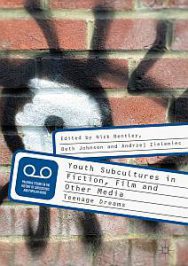With emphasis on “Teenage Dreams,” three loosely designed subdivisions – literary fictions, representations on screen, critical theory and representations in other media – approach the huge body of demonstrations of subcultures in popular culture in the title at hand.
 Already the very idea of subcultures is strongly connected to modes of narration: “One of the intentions of the book is to stress that the powerful narrative construction of individual subcultures and subcultural affiliation more broadly, is in part an imaginative and fictive construction.”
Already the very idea of subcultures is strongly connected to modes of narration: “One of the intentions of the book is to stress that the powerful narrative construction of individual subcultures and subcultural affiliation more broadly, is in part an imaginative and fictive construction.”
Naturally, teenagers and youth are in the focus here, as identity formation and certain rebellious attitudes, the presence of peer groups and other identity-markers are at work when young people – with a strong urge to differ from the cultural mainstream – decide to give their sympathies to a specific subculture with a particular way of dressing, a particular style, musical tastes and sometimes political outlook and preference for certain drugs.
“While there has been a long tradition of analysing youth cultures in various disciplines, there has been no book-length study of how youth subcultures have been portrayed in fiction, on screen and other media. … This collection brings together scholars working in literary studies, social and cultural studies whose research interests lie in the aesthetics and cultural politics of youth cultures.”
For example, we find texts on “bad girl fiction” in 1950s America, Mod culture at the movies over the years, Ray Gosling’s and Colin MacInnes’ presentation of queer men, punk culture in fiction of the last four decades, subcultural identities in black writing of Britain, Spanish street art and graffiti as well as youth portrayed in the movie Privilege (1967). Furthermore texts on representations of nightclubs in British films, recent rockumentaries (on Oasis and the Stone Roses) and the teenage dreamers in search of identity and the shifting nature of subcultural movements over the decades.
Also some usually underrepresented topics are touched, like Heavy Metal subculture: the mainstreaming of its subcultural tropes, its connection to the working class, and Heavy Metal’s presence in 1980s horror movies.
Concluding, this is a solid compilation of texts, and fortunately not just British subcultures (even though Britain has probably the largest number of subcultures to offer) are examined here, but also some of American and Spanish origin. Once again, Palgraves’s series “Studies in the History of Subcultures and Popular Music” has added another valuable title with a wide range of very different approaches to the many subcultural forms.
Review by Dr. A. Ebert © 2018
Nick Bentley, Beth Johnson and Andrzej Zieleniec (eds.) Youth Subcultures in Fiction, Film and Other Media: Teenage Dreams (Palgrave Studies in the History of Subcultures and Popular Music). Palgrave Macmillan, 2018, 292 p.
